

Hiragana42 Review. “Learn hiragana through mnemonics in a day” Hiragana42 is an ebook by Koichi (of Tofugu) for people looking to learn how to read hiragana.

Using mnemonics, it’s possible to learn all the hiragana in days or even hours (one person emailed us saying it took him 30 minutes to be able to read everything!). Since most Japanese resources require you to know at least hiragana, you’ll be opening doors to all sorts of other books you could never use previously. Hiragana42′s aim is to get you to that point very quickly without sacrificing quality.
Download Hiragana42 (Free) Pros Totally freeeeee! Cons Doesn’t cover hand writing hiragana (who writes with their hands these days anyways?). Pictures Final Word? TextFugu Review. TextFugu is an online Japanese textbook made by Koichi (from Tofugu, the site you’re looking at right now) for beginners of Japanese.
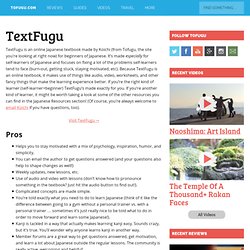
It’s made especially for self-learners of Japanese and focuses on fixing a lot of the problems self-learners tend to face (burn-out, getting stuck, staying motivated, etc). Because TextFugu is an online textbook, it makes use of things like audio, video, worksheets, and other fancy things that make the learning experience better. If you’re the right kind of learner (self-learner+beginner) TextFugu’s made exactly for you. If you’re another kind of learner, it might be worth taking a look at some of the other resources you can find in the Japanese Resources section! (Of course, you’re always welcome to email Koichi if you have questions, too).
Visit TextFugu → Pros Helps you to stay motivated with a mix of psychology, inspiration, humor, and simplicity.You can email the author to get questions answered (and your questions also help to shape changes as well!) JAPAN 041 First-Year Japanese, Part 1. Paper Course Instructor(s): Shauna K Palmer BACredits: 0.50 add to cart.
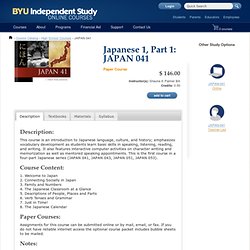
Teach Yourself Japanese. JapanesePod101.com (Audio) - Download free podcast episodes by Wizzard Media on iTunes. Learn Japanese Online for Free - its fun with easy flash quizes! Kanji Game, a free program for studying Japanese characters. Learn Hiragana, Katakana, compounds, and vocabulary. - Aurora. 21F.503 Intermediate Japanese I, Fall 2004. Foreign Languages and Literatures. 21F.505 Advanced Japanese I, Fall 2005. 21F.506 Advanced Japanese II, Spring 2005. Accent and Tricky Pronunciation : Lesson 1-2 : Japanese Lessons : AAW. Accent The Japanese accent is easy to learn, because there isn't one.
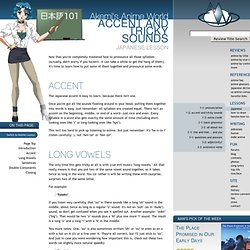
Once you've got all the sounds floating around in your head, putting them together into words is easy. Just remember: all syllables are created equal. There isn't an accent on the beginning, middle, or end of a word--just nice and even. Every syllable in a word also gets exactly the same amount of time (including short-looking ones like "i" or long-looking ones like "kyo"). This, That, The Other Thing, and You : Lesson 2-3 : Japanese Lessons : AAW. This, That, and The Other Thing.
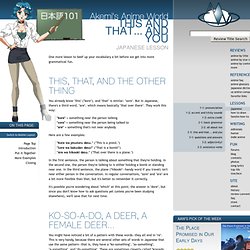
Questions and Answers : Lesson 3-1 : Japanese Lessons : AAW. Asking Questions Let's get right to the point and check out the basic way to ask a question in Japanese.
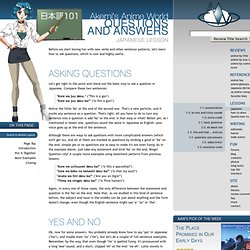
Compare these two sentences: "Kore wa juu desu. " ("This is a gun")"Kore wa juu desu ka? " ("Is this a gun? ") Notice the little "ka" at the end of the second one. Although there are ways to ask questions with more complicated answers (which we'll get to), and all of them are marked as questions by sticking a good ol' "ka" on the end, simple yes or no questions are so easy to make it's not even funny. "Kore wa uchuusen desu ka? " Again, in every one of those cases, the only difference between the statement and question is the "ka" on the end. Yes and No Ok, now for some answers. These conversations involve Mirai and Ryuu, whom you'll be seeing more of in future examples.
Adjectives : Lesson 3-2 : Japanese Lessons : AAW. Split the Difference Japanese adjectives are easy, because basically, they work exactly the same as English adjectives--you stick them in front of the word you want them to modify.
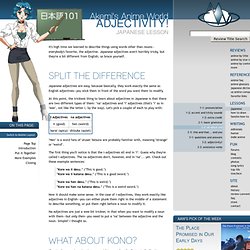
At this point, the trickiest thing to learn about adjectives in Japanese is that there are two different types of them: "na" adjectives and "i" adjectives (that's "i" as in "eee", not like the letter I, by the way). Let's pick a couple of each to play with: Being There: Existence Verbs : Lesson 3-3 : Japanese Lessons : AAW. Here, There, and Everywhere Before we get going, let's learn a new set of those ko-so-a-do words to go with places: "koko" = here (place where the speaker is)"soko" = there (place where the listener is)"asoko" = over there (place near neither the speaker or listener)"doko" = where These words follow the same pattern as all the other ko-so-a-do words, and have nice useful English equivalents.

Only one little issue: using them isn't quite so simple. Learn Japanese » Introduction. Learn Japanese Words - Core 100 List.